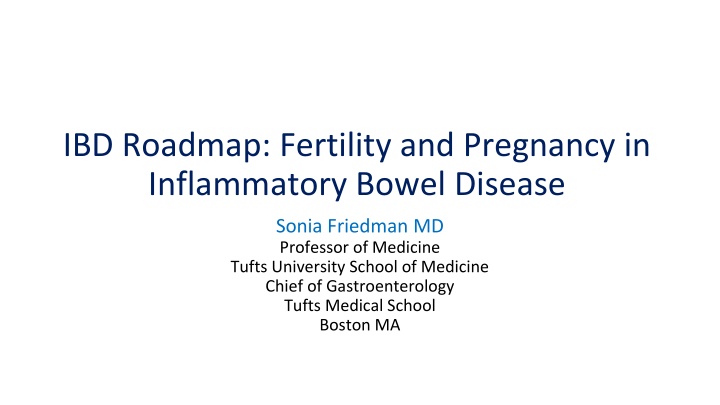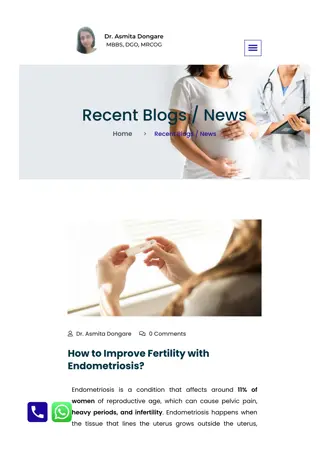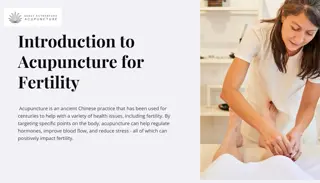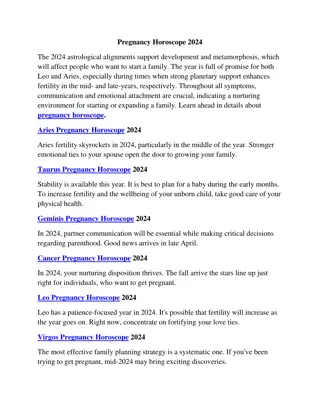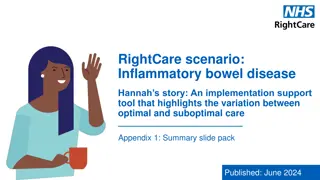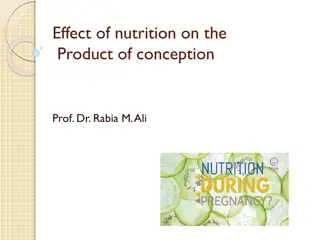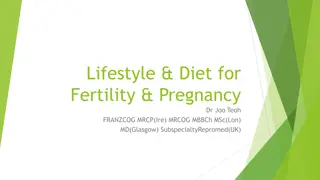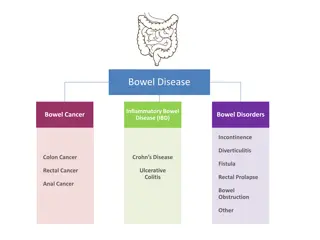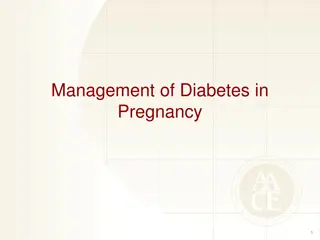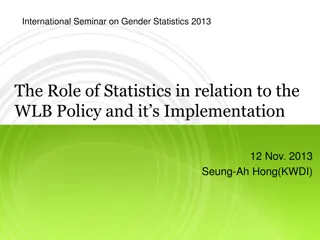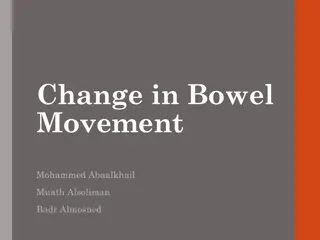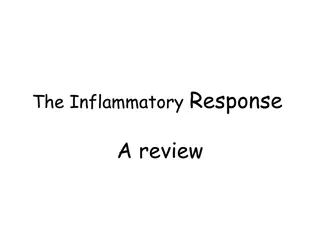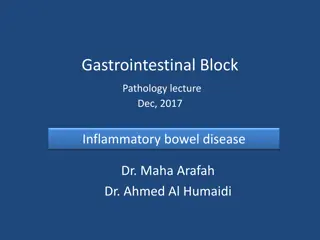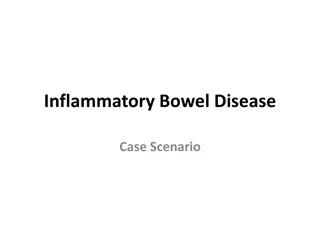Fertility and Pregnancy in Inflammatory Bowel Disease
The impact of inflammatory bowel disease on fertility and pregnancy, discussing factors influencing voluntary childlessness, surgical procedures, measuring fertility outcomes, and time to pregnancy in women with IBD. Understand the challenges and effects on reproductive health in individuals with IBD.
Download Presentation

Please find below an Image/Link to download the presentation.
The content on the website is provided AS IS for your information and personal use only. It may not be sold, licensed, or shared on other websites without obtaining consent from the author.If you encounter any issues during the download, it is possible that the publisher has removed the file from their server.
You are allowed to download the files provided on this website for personal or commercial use, subject to the condition that they are used lawfully. All files are the property of their respective owners.
The content on the website is provided AS IS for your information and personal use only. It may not be sold, licensed, or shared on other websites without obtaining consent from the author.
E N D
Presentation Transcript
IBD Roadmap: Fertility and Pregnancy in Inflammatory Bowel Disease Sonia Friedman MD Professor of Medicine Tufts University School of Medicine Chief of Gastroenterology Tufts Medical School Boston MA
IBD and Reproduction Father with IBD Pregnancy loss/ ectopic1 pregnancy/elective abortion2 Effects of: Effects of: Disease activity Medications Surgery Depression Hypogonadism Disease flare Medications Surgery Ovarian reserve Voluntary childlessness Viable intrauterine pregnancy Mother with IBD Sexual function Fertility Pregnancy Conception 1de Silva P et al. Clin Gastroenterol Hepatol. 2018; 16(1):83-89; 2N rg rd BM et al. Inflammatory Bowel Diseases. 2018
Factors that might contribute to voluntary childlessness Fear of inheritance No desire for a child Fear of IBD activity Sexual dysfunction Lack of appropriate family structure Social circumstances Fear of medications Women with IBD are significantly more likely to remain voluntarily childless compared to the general population (17% versus 6%)1,2 1Nguyen et al., Gastro 2016, 2Selinger et al., JCC 2016.
IBD surgery Uterine receptivity Sexual dysfunction Disease activity Former reproductive history Fertility in IBD IBD medications Low ovarian reserve Lifestyle factors Abnormal sex hormone levels Women who want to become pregnant: Impact of IBD on fertility
Measuring fertility in IBD Swedish National register: UC, CD, IBD-U Fertility = the number of babies born Contraceptive use after 2005 27,331 women (12 237 with UC, 8672 with CD and 6422 with IBD- U). Matched cohort [5:1] included 131 892 women Fertility reduced in CD cohort (HR 0.88, 95% confidence interval [CI] 0.85 0.91), IBD-U cohort (HR 0.86, 95% CI 0.83 0.89) but only marginally reduced in UC cohort (HR 0.96, 95% CI 0.93 0.98) Reduced fertility associated with: hospital admissions, increasing number of bowel resections and perianal disease Druvefors. JCC 2021
Time to pregnancy in women with and without IBD Friedman et al., Clinical Gastroenterology and Hepatology 2019.
Time to pregnancy is longer in women with Crohn s disease and Crohn s disease surgery
Ovarian reserve in Crohns disease Definition: The capacity of the ovary to provide egg cells that are capable of fertilization resulting in a healthy and successful pregnancy. Measurement: anti-Mullerian hormone (AMH) is a good indicator of ovarian reserve Low ovarian reserve in CD associated with: Age >30y1 Colonic disease1 Higher disease activity2 Disease duration >5y2 Surgery did not affect ovarian reserve2 AMH level of women with CD or UC of reproductive age was significantly lower than that of healthy women3 AMH level of women with CD or UC of reproductive age in remission was lower than that of healthy women3 1Freour, Inflamm Bowel Dis 2012; 2Senates, J Crohns Colitis 2013; 3Guo et al, Medicine 2023.
Post-surgical conception Fertility is decreased three-fold after ileoanal pouch anastomosis (IPAA)1. Fertility is greatly improved with laparoscopic IPAA2,3. Fertility is decreased after proctectomy, but studies are lacking. 1Waljee et al., Gut 2006; 2Bartels et al., Ann Surgery 2012; 3Beyer-Berjot et al., Ann Surgery 2013;
Post-surgical conception and assisted reproductive technology (ART): clinical practice Discuss issue of fertility with patients contemplating surgery but emphasize that there are good outcomes with laparoscopy and ART if needed. NEVER withhold needed surgery based on fear of infertility1,2,3 Criteria for ART referral include failure to conceive for: >1 year in any IBD patient Any post surgical IBD patient with irregular cycles >3 cycles in a post surgical patient (proctectomy + ostomy or IPAA) 1Cornish et al., Dis Colon Rectum 2007; 2Rajartnam et al., Int J Colorectal Dis 2011; 3Wikland et al., Int J Colorectal Dis 1990.
ART in women with IBD: Denmark studies Live birth per embryo transfer in UC women Exposed cohort (embryo transfers in women with UC) N = 1360 Unexposed cohort (embryo transfers in non- IBD women) N = 148,540 Crude OR 95% CI Adjusted OR 95% CI Adjusted OR 95% CI Live birth Yes, N (%) No, N (%) 272 (20.00) 1088 (80.00) 35,321 (23.78) 113,219 (76.22) 0.79 (0.67 - 0.92) 0.78 (0.67- 0.91) 0.73 (0.58- 0.92) N rg rd BM et al. Gut. 2016;65(5):767-76.
ART in women with IBD: Denmark studies Live birth per embryo transfer in CD women Exposed cohort (embryo transfers in women with CD) N = 554 Unexposed cohort (embryo transfers in non-IBD women) N =148,540 Crude OR 95% CI Adjusted OR 95% CI Adjusted OR 95% CI Live birth Yes, N (%) No, N (%) 94 (16.97) 460 (83.03) 35,321 (23.78) 113,219 (76.22) 0.62 (0.48- 0.80) 0.61 (0.47- 0.79) 0.77 (0.52- 1.14)
Surgery for CD decreases live births per embryo transfer Exposed cohort (embryo transfers in CD women who had prior surgery) N= 355 Unexposed cohort (embryo transfers in CD women who had no prior surgery) N = 199 Crude OR 95% CI Adjusted OR1 95% CI Live birth Yes, N (%) No, N (%) 50 (14.08) 305 (85.92) 44 (22.11) 155 (77.89) 0.56 (0.33- 0.93) 0.51 (0.29- 0.91)
The failure to achieve a live birth is a failure to achieve a clinical pregnancy Why? IVF technique? Subclinical disease? Microbiome changes? Autoimmunity? IBD Medications? Differences in reproductive hormones? What implications does this have for all women with IBD wishing to have children?
Preconception care: IBD clinical practice All IBD patients should see a maternal fetal medicine specialist Goals of care1,2,3: Confirm patient is in remission Discontinue teratogenic medications (including methotrexate) Folic acid and iron supplementation Optimize management of comorbidities Discuss previous obstetric history Update immunizations Screen for substance use, counsel smoking and alcohol cessation Discussion and education regarding: Safety of most IBD medications during pregnancy and lactation Need to be in remission and avoid active IBD during pregnancy Optimal mode of delivery 1Nguyen et al., Gastro 2016; 2van der Woude JCC 2015; 3Palomba et al., World J Gastroenterol 2014
Impact of pregnancy on maternal IBD IBD (ulcerative colitis and Crohn s disease) % patients in remission during pregnancy % patients with aggravated or persistent disease activity during pregnancy 30 Remission at the time of conception Active disease at the time of conception 70 30 70 1) 2) 3) 4) Heetun ZS. Reproduction in patients with inflammatory bowel disease. Aliment Pharmacol Ther 2007; 26: 513-533 Palomba S. Inflammatory bowel disease and human reproduction: a comprehensive evidence-based review. World J Gastroenterol 2014; 20: 7123-7136 Van der Woude J. European evidenced-based consensus on reproduction in inflammatory bowel disease. Journal of Crohn s and Colitis 2010; 4: 493-510 Woude et al. The second European evidenced-based consensus on reproduction and pregnancy in inflammatory bowel disease. Journal of Crohn s and Colitis 2015, 107-124
Preventing possible adverse outcomes Low birth weight and preterm birth are the main predictors for perinatal mortality and morbidity Impaired intrauterine growth predicts chronic diseases in adulthood
Preconception care leads to less disease relapse during pregnancy Prospective study; 2008-2013 Females of reproductive age with IBD attending IBD Pregnancy Outpatient Clinic (POC) Study group (n=149): preconception IBD POC counseling (30-minute consult) Control group (n=105): patients attending IBD POC when already pregnant Results: Control group (105) Study group (149) N= 254 Better 46 87 X Folate intake 1 19 X Smoking cessation Discontinuation of IBD meds due to concerns of side effects 8 0 X 16 12 Periconceptual disease activity 34 20 X Disease activity during pregnancy de Lima et al., Clin Gastro Hepatol 2016
Predictors of disease activity during pregnancy in women with IBD Aarhus University, Denmark Physician s global assessment - escalation in medical treatment, clinical disease scores, biomarker(s) of inflammation Preconception, conception each trimester 378 women, 609 pregnancies Predictors of disease activity: Disease activity in previous pregnancy aOR of 3.2 [1.5 6.6]; p = 0.002. Preconception disease activity aOR of 5.3 [3.5 8.2]; p < 0.001 UC phenotype aOR = 2.6 [1.8 3.9]; p < 0.001. Consequences of disease activity: Lower birth weight when compared to women who were in remission throughout pregnancy, higher prevalence of CS and fetal growth restriction Vestergaard. APT 2023
How do we evaluate disease activity during pregnancy? www.flickr.com www.photobucket.com www.beliefnet.com www.syrvet.com www.active8health.net
Management of the flaring IBD pregnant patient Medication choices are similar Avoid new aza/6mp in pregnancy OK to start prednisone for flares Okay to start biologics Avoid metronidazole in first trimester (T1) Laboratory/Stool Tests C. difficile Fecal calprotectin (CRP, ALB, HGB are useless) Imaging MRI preferred to CT, though no IV contrast Ultrasound Endoscopy: Flexible sigmoidoscopy with no sedation Surgery: Indications similar to non-pregnant patient; 2ndtrimester best
